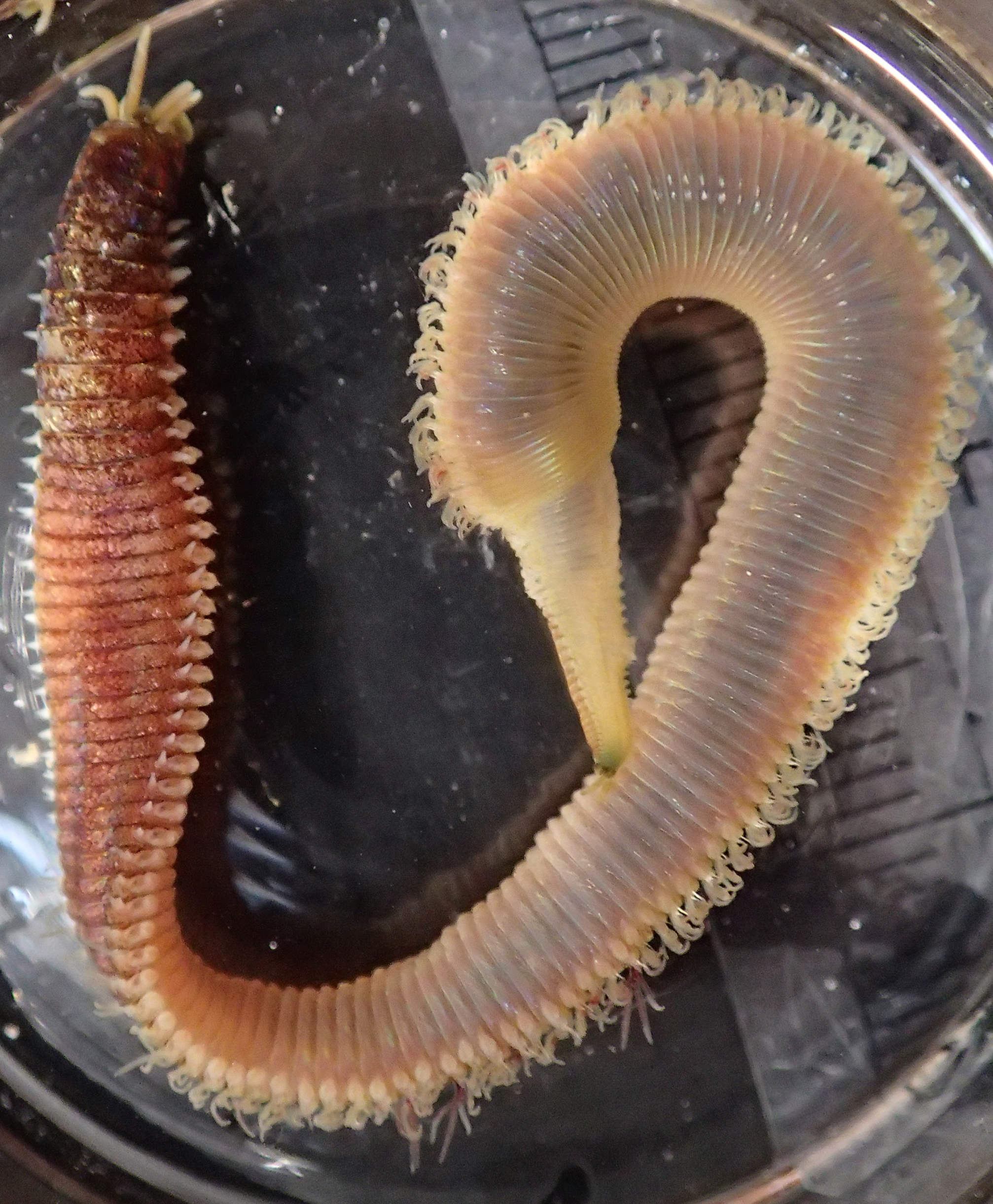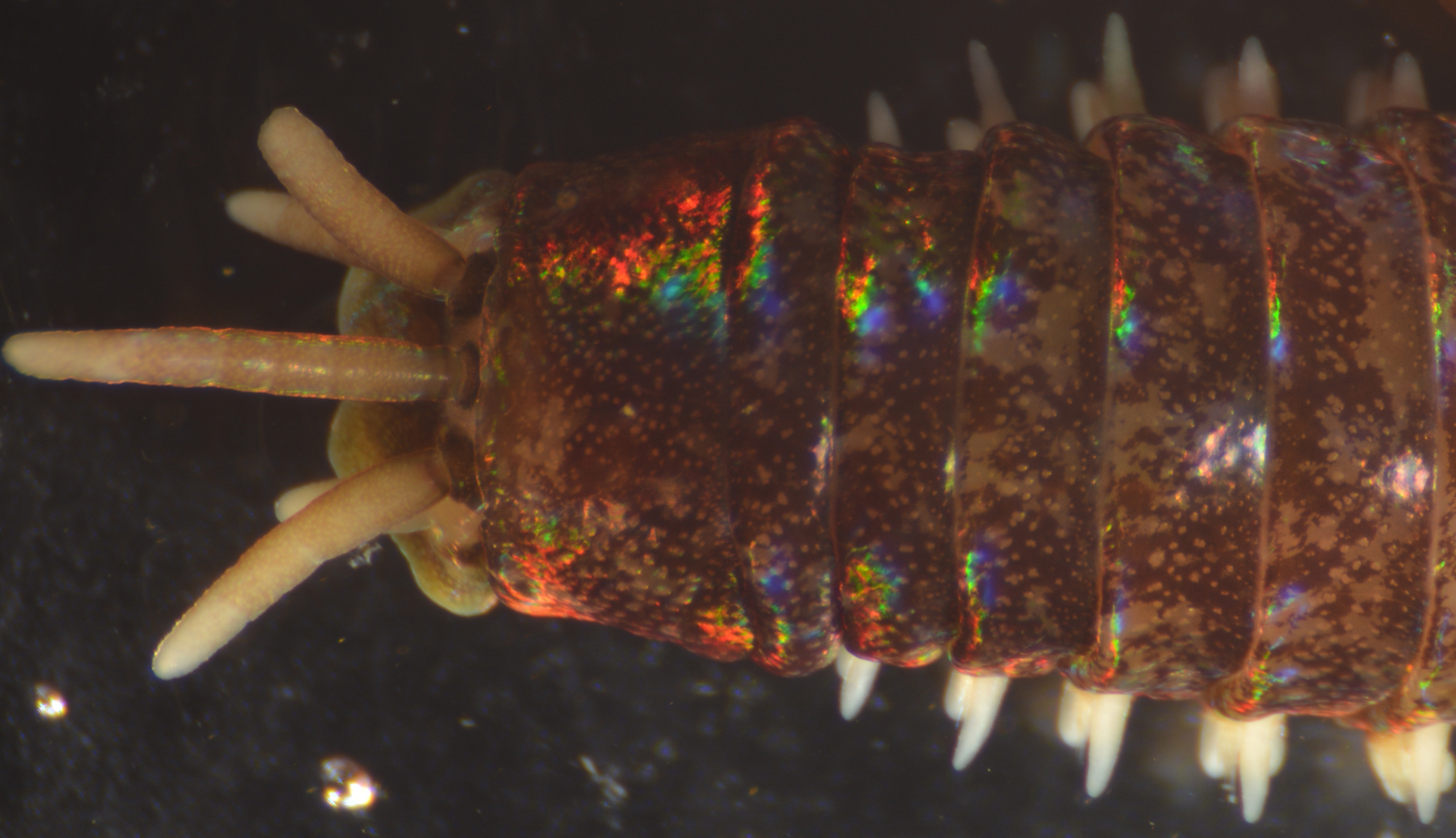A eunicid polychaete specimen was obtained at Oshoro Bay, Hokkaido, Japan, about 43°21′N, 140°86′E, on 2 June 2014 by Tatsuhiko Komura and Kana Ishii, identified by Hiroshi Kajihara as Marphysa sanguinea (Montagu, 1815), and photographed and fixed in 99% EtOH by Takumi Onishi. Total DNA was extracted from the posterior half of the body using the silica method (Boom et al. 1990) with some modifications. Extracted DNA was dissolved in 30 µl of deionized water and has been preserved at –20°C. Remaining morphological voucher specimen has been deposited at the Hokkaido University Museum under the catalogue number ICHU2120948 (contact: Dr. Hiroshi Kajihara, kazi@mail.sci.hokudai.ac.jp).
PCR amplification was attempted using the primer pair LCO1490 (5′-GGTCAACAAATCATAAAGATATTGG-3′) and HCO2198 (5′-TAAACTTCAGGGTGACCAAAAAATCA-3′) (Folmer et al. 1994) for the mitochondrial cytochrome c oxidase subunit I (COI) gene, which, however, was unsuccessful. We obtained an about 1000-bp fragment of the nuclear 28S rRNA gene that was amplified by using LSU5 (5′-ACCCGCTGAAYTTAAGCA-3′) and LSU3 (5′-TCCTGAGGGAAACTTCGG-3′) (Littlewood 1994). A hot start PCR was performed by a thermal cycler, 2720 Thermal Cycler (Applied Biosystem), in a 20-µl reaction volume containing 1 µl of template total DNA (approximately 10–100 ng) and 19 µl of premix made with 632-µl deionized water, 80-µl Ex Taq Buffer (TaKara Bio), 64-µl dNTP (each 25 mM), 8-µl each primer (each 10 µM), and 0.1-µl TaKara Ex Taq (5 U/µl,TaKara Bio). Thermal cycling condition comprised an initial denaturation at 95°C for 30 sec; 30 cycles of denaturation at 95°C for 30 sec, annealing at 45°C for 30 sec, and elongation at 72°C for 45 sec (for COI) or 3 min (for 28S), and a final elongation at 72°C for 7 min.
The PCR product was purified with the silica method (Boom et al. 1990). Both strands were sequenced with a BigDye® Terminator v3.1 Cycle Sequencing Kit (Applied Biosystems) following the manufacturer's protocol, using the same primer set and as the initial PCR amplification, as well as D2F (5′-CTTTGAAGAGAGAGTTC-3′) (Littlewood 1994) and 28z (5′-CTTGGTCCGTGTTTCAAGAC-3′) (Hillis and Dixon 1991) as internal primers. Sequencing was performed with ABI Prism 3730 DNA Analyzer (Applied Biosystems). Chromatogram and sequence data were operated with MEGA v.5 software (Tamura et al. 2011).
Results
Phylum Annelida
Family Eunicidae Berthold, 1827
Genus Marphysa Quatrefages, 1865
Marphysa sanguinea (Montagu, 1815)
[Japanese name: iwamushi]
(Figs 1, 2)
A total of 327 bp of 28S rRNA sequence was determined from Marphysa sanguinea (see Appendix). The chromatogram data generated by the sequencer were mostly dirty. Due to the low quality, we were able to reliably determine only 327 bases near the 5′ end of the PCR products from our material (see Appendix). A nucleotide BLAST search (Altschul et al. 1997) at the NCBI website (https://blast.ncbi.nlm.nih.gov/) showed that our sequence from Oshoro was 98% identical with AY838861 (100% in query coverage; E value = 9e–159), a sequence from the same species, probably from European waters (Struck et al. 2006).

Fig. 1. Marphysa sanguinea (Montagu, 1815), ICHU2120948, entire animal.

Fig. 2. Marphysa sanguinea (Montagu, 1815), ICHU2120948, magnification of the head.
References
Boom, R., Sol, C. J. A., Salimans, M. M. M., Jansen, C. L., Wertheim-van Dillen, P. M. E., and van der Noordaa, J. 1990. Rapid and simple method for purification of nucleic acids. Journal of Clinical Microbiology 28: 495–503.
Folmer, O., Black, M., Hoeh, W., Lutz, R. and Vrijenhoek, R. 1994. DNA primers for amplification of mitochondrial cytochrome c oxidase subunit I from diverse metazoan invertebrates. Molecular Marine Biology and Biotechnology 3: 294–299.
Hillis, D. M. and Dixon, M. T. 1991. Ribosomal DNA: molecular evolution and phylogenetic inference. Quarterly Riview of Biology 66: 411–453.
Littewood, D. T. 1994. Molecular phylogenetics of cupped oysters based on partial 28S rRNA gene sequences. Molecular Phylogenetics and Evolution 3: 221–229.
Struck, T. H., Purschke, G., and Halanych, K. M. 2006. Phylogeny of Eunicida (Annelida) and exploring data congruence using a partition addition bootstrap alteration (PABA) approach. Systematic Biology 55: 1–20.
Tamura, K.,Peterson, D., Peterson, N., Stecher, G., Nei, M., and Kumar, S. 2011. MEGA5: molecullar evolutionary genetics analysis using maximum likelihood, evolutionary distance, and mamaximum parsimony methods. Molecular Biology and Evolution 28: 2731–2739.
Appendix
28S rRNA sequence from ICHU2120948 identidied as Marphysa sanguinea (Montagu, 1815).
CAGCTACTAGATGGTTCGATTAGTCTTTCGCCCCTATACCCAAGTTTGACGATCGATTTGCACGTCAGAATCGCTACGGTCCTCCACCAGAGTTTCCTCTGGCTTCGACCTACTCAGGCATAGTTCACCATCTTTCGGGTCCCAACAGGTACGCTCTTGCTCCGCCTCCCCGACCGAAGAACGGGACGGACGAGACGGGCCGGTGTTGCGCCCACCCTCAGCGGGGCAGGATCACACCTAGGCCGACAAGCGAGGCCAGCCTTCACTTTCATTACGCCTTTAGGATTCGTGAGTCCCAATGACTCGCGCACATGTTAGGCCCCTCGG